|
|
 |
Fiche d'espèce de Copépode |
|
|
Calanoida ( Ordre ) |
|
|
|
Calanoidea ( Superfamille ) |
|
|
|
Paracalanidae ( Famille ) |
|
|
|
Calocalanus ( Genre ) |
|
|
| |
Calocalanus styliremis Giesbrecht, 1888 (F,M) | |
| | | | | | | Syn.: | no Calocalanus styliremis : Bradford, 1972 (p.34, figs.F);
Calocalanus styliremis s.l. : Brinton & al., 1986 (p.228, Table 1); | | | | Ref.: | | | Giesbrecht, 1892 (p.176, 185, 770, figs.F,M); Giesbrecht & Schmeil, 1898 (p.26, Rem. F,M); Farran, 1908 b (p.22); Früchtl, 1923 a (p.149, figs.F, Rem.); Sars, 1925 (p.27); Farran, 1926 (p.234, figs.F, Rem.); 1929 (p.208, 222); Sewell, 1929 (p.89); Rose, 1933 a (p.76, figs.F,M); Hardy & Gunther, 1935 (p.147); Farran, 1936 a (p.83); Wilson, 1942 a (p.173, figs.juv.M; Vervoort, 1946 (p.138); Farran & Vervoort, 1951 d (n°36, p.3, figs.F) Tanaka, 1956 c (p.379, figs.F); 1960 (p.30); Bernard, 1960 (n°36 first revision, p.4, figs.F); Vervoort, 1963 b (p.114: as C. styliremus, Rem.); Tanaka, 1964 (p.6); Chen & Zhang, 1965 (p.45, 130: Rem., figs.F); Corral Estrada, 1970 (p.117, figs.F, M, Rem.); Björnberg, 1972 (p.20, figs.N, Rem.N); Bradford, 1972 (p.34, figs.F); Razouls, 1972 (p.94, Annexe: p.23, figs.F); Corral, 1972 b (n°138, p.4, 5, figs.F,M); Chen & Zhang, 1974 (p.108, figs.M); Dawson & Knatz, 1980 (p.4, figs.F,M); Björnberg & al., 1981 (p.604, 624, figs.F,M); Gardner & Szabo, 1982 (p.164, figs.F,M); Zheng & al., 1982 (p.26, Fig.F); Sazhina, 1985 (p.42, figs.N); Bradford-Grieve, 1994 (p.64, figs.F,M, fig.99); Chihara & Murano, 1997 (p.750, Pl.71: F,M); Bradford-Grieve & al., 1999 (p.877, 909, figs.F,M); Conway & al., 2003 (p.203, figs.F,M, Rem.); Boxshall & Halsey, 2004 (p.154: figs.F,M); Avancini & al., 2006 (p.72, Pl. 41, figs.F,M, Rem.); Vives & Shmeleva, 2007 (p.958, figs.F,M, Rem.) | 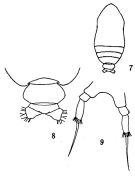 issued from: Q.-c Chen & S.-z. Zhang in Studia Marina Sinica, 1965, 7. [Pl.10, 7-9]. Female (from E China Sea): 7, habitus (dorsal); 8, urosome (dorsal); 9, P5 (posterior).
|
 issued from : J. Corral Estrada in Tesis Doct., Univ. Madrid, A-129, Sec. Biologicas, 1970. [Lam.28]. Female (from Canarias Is.): 1, habitus (dorsal); 2, distal segments of A1; 3, P5; 4, habitus (dorsal, another specimen); 5, P5; 6, habitus (dorsal, another individual); 7, distal segments of A1; 8, P4; 9, P5.
|
 issued from : J. Corral Estrada in Tesis Doct., Univ. Madrid, A-129, Sec. Biologicas, 1970. [Lam.29]. Female: 1, habitus (dorsal); 2, P1; 3, P2; 4, P3; 5, P4; 6, P5. Male: 7, P2; 8, P3; 9, endopodal segments of P4; 10, P5.
|
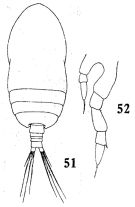 issued from : Q.-c. Chen & S.-z. Zhang in Studia Marina Sinica, 1974, 9. [Pl.5, Figs. 51-52]. Male (from South China): 51, habitus (dorsal); 52, P5.
|
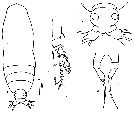 issued from : Z. Zheng, S. Li, S.J. Li & B. Chen in Marine planktonic copepods in Chinese waers. Shanghai Sc. Techn. Press, 1982 [p.27, Fig.14]. Female: a, habitus (dorsal); b, urosome (dorsal); c, P4; d, P5. Scale in mm.
|
 issued from : J.M. Bradford in Mem. N. Z. Oceonogr. Inst., 1972, 54. [p.35, Fig.5 (13-14)]. Female (from Kaikoura, New Zealand): 13, habitus (dorsal); 14, P5. Scale bars: 1 mm (13); 0.01 mm (14).
|
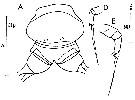 issued from : C. Razouls in Th. Doc. Etat Fac. Sc. Paris VI, 1972, Annexe. [Fig.27, A, D-E]. Female (from Banyuls, G. of Lion): A, urosome; D-E, P5 (from two specimens)
|
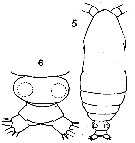 issued from : G.P. Farran in Biscayan Plankton collected during a Cruise of H.M.S. 'Research', 1900.- Part XIV. The Copepoda. (Linn. Journ. Zoology, XXXVI, 1926). [p.303, Pl.5, Figs.5-6]. Female: 5, habitus (dorsal); 6, urosome (dorsal).
|
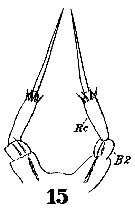 Issued from : W. Giesbrecht in Systematik und Faunistik der Pelagischen Copepoden des Golfes von Neapel und der angrenzenden Meeres-Abschnitte. – Fauna Flora Golf. Neapel, 1892, 19 , Atlas von 54 Tafeln. [Taf.9, Fig.15]. Female: 15, P5 (anterior view).
|
 Issued from : W. Giesbrecht in Systematik und Faunistik der Pelagischen Copepoden des Golfes von Neapel und der angrenzenden Meeres-Abschnitte. – Fauna Flora Golf. Neapel, 1892, 19 , Atlas von 54 Tafeln. [Taf.9, Fig.18]. Female: 18, distal segments of A1.
|
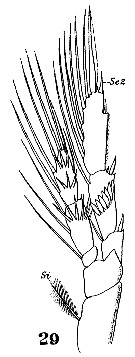 Issued from : W. Giesbrecht in Systematik und Faunistik der Pelagischen Copepoden des Golfes von Neapel und der angrenzenden Meeres-Abschnitte. – Fauna Flora Golf. Neapel, 1892, 19 , Atlas von 54 Tafeln. [Taf.9, Fig.29]. Female: 29, P4 (posterior view).
|
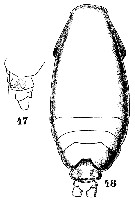 Issued from : W. Giesbrecht in Systematik und Faunistik der Pelagischen Copepoden des Golfes von Neapel und der angrenzenden Meeres-Abschnitte. – Fauna Flora Golf. Neapel, 1892, 19 , Atlas von 54 Tafeln. [Taf.36, Figs.47, 48]. Female: 47, last thoracic segment with P5 and urosome (lateral); 48, habitus (dorsal).
|
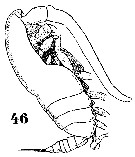 Issued from : W. Giesbrecht in Systematik und Faunistik der Pelagischen Copepoden des Golfes von Neapel und der angrenzenden Meeres-Abschnitte. – Fauna Flora Golf. Neapel, 1892, 19 , Atlas von 54 Tafeln. [Taf.36, Fig.46]. Male: 46, habitus (lateral).:
|
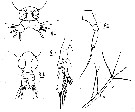 Issued from : M. Bernard in Bull. Soc. Zool. France, 1958, 83. [p.189, Figs. 6 a, b, 7, 8 a, b]. Calocalanus styliremis (from Alger Bay, Algeria): 6a, P5; 6b, P4; 7, terminal segments of A1; 8a-8b, urosome (two aspects). Lengths: Urosome: 0.150 mm.
|
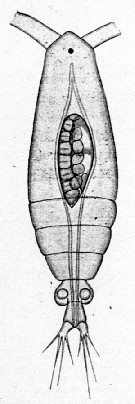 Issued from : E. Chatton in Arch. Zool. Exp. & Gen., 1920, 59, [p.122, Fig.23]. Calocalanus styliremis female (from Banyuls) parasited by Blastodinium crassum (Dinoflagellate). Nota: The infestation index shows that the species is weak by comparison with Paracalanus parvus and Clausocalanus furcatus, but the latters very much abundant in the samples.
|
 Issued from : E. Chatton in Arch. Zool. Exp. & Gen., 1920, 59, [p.178, Fig.81]. Calocalanus styliremis female (from Banyuls) parasited by Blastodinium contortum (Dinoflagellate), very twisted in the copepod's gut.
| | | | | Ref. compl.: | | | Pearson, 1906 (p.9); Chatton, 1920 (p.17, parasite); Rose, 1925 (p.151); Hardy & Gunther, 1935 (1936) (p.147, Rem.); Sewell, 1948 (p.323, 381, 391, 395, 407, 414, 453, 460, 462, 468, 469, 473, 477, 478, 481, 493); C.B. Wilson, 1950 (p.180); Yamazi, 1958 (p.148, Rem.); Fagetti, 1962 (p.13); Grice & Hart, 1962 (p.287, 293: Rem.); Gaudy, 1962 (p.93, Rem.: p.104); Duran, 1963 (p.14); V.N. Greze, 1963 a (tabl.2); Shmeleva, 1963 (p.141); Ahlstrom & Thrailkill, 1963 (p.57, Table 5, abundance); Grice, 1963 a (p.495); Björnberg, 1963 (p.30, Rem.); De Decker, 1964 (p.15, 18, 29); De Decker & Mombeck, 1964 (p.11); Grice & Hulsemann, 1965 (p.223); Shmeleva, 1965 b (p.1350, lengths-volume -weight relation); Neto & Paiva, 1966 (p.21, Table III); Mazza, 1966 (p.69); 1967 (p.355: Rem.); Pavlova, 1966 (p.43); Grice & Hulsemann, 1967 (p.14); Fleminger, 1967 a (tabl.1); De Decker, 1968 (p.45); Park, 1970 (p.475); Deevey, 1971 (p.224); Carli, 1971 (p.372, tab.1); Apostolopoulou, 1972 (p.327, 340); Binet & al., 1972 (p.71); Roe, 1972 (p.277, tabl.1, tabl.2); Bainbridge, 1972 (p.61, Appendix Table I: vertical distribution vs day/night, as sryliremus); Björnberg, 1973 (p.308, 384); Corral Estrada & Pereiro Muñoz, 1974 (tab.I); de Bovée, 1974 (p.109, 124); Vives & al., 1975 (p.35, tab.II, III, IV); Peterson & Miller, 1976 (p.14, Table 1, 3, abundance vs interannual variations); 1977 (p.717, Table 1, seasonal occurrence); Deevey & Brooks, 1977 (p.256, tab.2, Station "S"); Carter, 1977 (1978) (p.35); Comaschi Scaramuzza, 1978 (p.17); Vaissière & Séguin, 1980 (p.23, tab.1); Kovalev & Schmeleva, 1982 (p.83); Brenning, 1982 (p.5, spatial distribution, T-S diagram, Rem.); Vives, 1982 (p.290); De Decker, 1984 (p.315, 334: chart); Guangshan & Honglin, 1984 (p.118, tab.); Roe, 1984 (p.356); Scotto di Carlo & al., 1984 (1042); Brenning, 1985 a (p.24, Table 2); Moraitou-Apostolopoulou, 1985 (p.303, occurrence/abundance in E Mediterranean Sea, Rem.: p.310); Regner, 1985 (p.11, Rem.: p.25); Almeida Prado Por, 1985 (p.250); Comaschi Scaramuzza, 1987 (tab.1); Lozano Soldevilla & al., 1988 (p.57 as stylimeris); McKinnon, 1991 (p.471); Shih & Marhue, 1991 (tab.2, 3); Seguin & al., 1993 (p.23, 26: Rem.); Oliveira Dias, 1995 (p.147); Shih & Young, 1995 (p.71); Hajderi, 1995 (p.542); Siokou-Frangou, 1997 (tab.1); Hure & Krsinic, 1998 (p.100); Noda & al., 1998 (p.55, Table 3, occurrence); Lopes & al., 1998 (p.195); Suarez-Morales & Gasca, 1998 a (p108); Seridji & Hafferssas, 2000 (tab.1); Lavaniegos & Gonzalez-Navarro, 1999 (p.239, Appx.1); Razouls & al., 2000 (p.343, Appendix); Ueda & al., 2000 (tab.1); d'Elbée, 2001 (tabl. 1); Holmes, 2001 (p.38); Peterson & al. 2002 (p.381, Table 2, interannual abundance); Zerouali & Melhaoui, 2002 (p.91, Tableau I); Bode & al., 2003 (p.85, Table 1, abundance); Peterson & Keister, 2003 (p.2499, interannual variability); Keister & Peterson, 2003 (p.341, Table 1, abundance, cluster species vs hydrological events); Vukanic, 2003 (139, tab.1); Hsieh & al., 2004 (p.397, tab.1); Rezai & al., 2004 (p.490, tab.2, comme styliformis); Lan & al., 2004 (p.332, tab.1); Fernandez de Puelles & al., 2004 (p.654, fig.7); Lo & al., 2004 (p.89, tab.1); Fernandez & al., 2004 (p.501, tab.5); Rezai & al., 2005 (p.157, Table 5: spatial & temporal variations); Isari & al., 2006 (p.241, tab.II); Fernandez de Puelles & al., 2007 (p.340: fig.7); Valdés & al., 2007 (p.103: tab.1); Dur & al., 2007 (p.197, Table IV); Khelifi-Touhami & al., 2007 (p.327, Table 1); McKinnon & al., 2008 (p.844: Tab.1); Cabal & al., 2008 (289, Table 1); Morales-Ramirez & Suarez-Morales, 2008 (p.518); Galbraith, 2009 (pers. comm.); Chiba & al., 2009 (p.1846, Table 1, occurrence vs temperature change); Licandro & Icardi, 2009 (p.17, Table 4); Lidvanov & al., 2010 (p.356, Table 3); Hidalgo & al., 2010 (p.2089, fig.4, Table 2, cluster analysis); Mazzocchi & Di Capua, 2010 (p.426); Medellin-Mora & Navas S., 2010 (p.265, Tab. 2); Fazeli & al., 2010 (p.153, Table 1); W.-B. Chang & al., 2010 (p.735, Table 2, abundance); Maiphae & Sa-ardrit, 2011 (p.641, Table 2, 3, Rem.); Isari & al., 2011 (p.51, Table 2, abundance vs distribution); Andersen N.G. & al., 2011 (p.71, Fig.3: abundance); Tutasi & al., 2011 (p.791, Table 2, abundance distribution vs La Niña event); Keister & al., 2011 (p.2498, interannual variation); Johan & al., 2012 (2013) (p.1, Table 1); Uysal & Shmeleva, 2012 (p.909, Table I); DiBacco & al., 2012 (p.483, Table S1, ballast water transport); Dorgham & al., 2012 (p.473, Table 3: abundance %); Hidalgo & al., 2012 (p.134, Table 2); Belmonte & al., 2013 (p.222, Table 2, abundance vs stations); Cornils & Blanco-Bercial, 2013 (p.861, Table 1, molecular analysis, figs.3, 4, 5); in CalCOFI regional list (MDO, Nov. 2013; M. Ohman, pers. comm.); Terbiyik Kurt & Polat, 2013 (p.1163, Table 2, seasonal distribution); Tachibana & al., 2013 (p.545, Table 1, seasonal change 2006-2008); Sobrinho-Gonçalves & al., 2013 (p.713, Table 2, fig.8, seasonal abundance vs environmental conditions); Lidvanov & al., 2013 (p.290, Table 2, % composition) ; Pansera & al., 2014 (p.221, Table 2, abundance); Mazzocchi & al., 2014 (p.64, Table 3, 4, 5, spatial & seasonal composition %); Zakaria, 2014 (p.3, Table 1, abundance vs 1960-2000); Zakaria & al., 2016 (p.1, Table 1);Benedetti & al., 2016 (p.159, Table I, fig.1, functional characters); Ben Ltaief & al., 2017 (p.1, Table III, Summer relative abundance); El Arraj & al., 2017 (p.272, table 2); Benedetti & al., 2018 (p.1, Fig.2: ecological functional group); Belmonte, 2018 (p.273, Table I: Italian zones); Chaouadi & Hafferssas, 2018 (p.913, Table II: occurrence); Palomares-Garcia & al., 2018 (p.178, Table 1: occurrence); Hirai & al., 2020 (p.1, Fig. 5: cluster analysis (OTU), spatial distribution). | | | | NZ: | 20 | | |
|
Carte de distribution de Calocalanus styliremis par zones géographiques
|
| | | | | | | | | | | | | | |  issued from : A.A. Shmeleva in Bull. Inst. Oceanogr., Monaco, 1965, 65 (n°1351). [Table 6: 12 ]. Calocalanus styliremis (from South Adriatic). issued from : A.A. Shmeleva in Bull. Inst. Oceanogr., Monaco, 1965, 65 (n°1351). [Table 6: 12 ]. Calocalanus styliremis (from South Adriatic).
Dimensions, volume and Weight wet. Means for 50-60 specimens. Volume and weight calculated by geometrical method. Assumed that the specific gravity of the Copepod body is equal to 1, then the volume will correspond to the weight. |
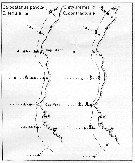 issued from : U. Brenning in Wiss. Z. Wilhelm-Pieck-Univ. Rostock - 31. Jahrgang 1982. Mat.-nat. wiss. Reihe, 6. [p.5, Fig.7]. issued from : U. Brenning in Wiss. Z. Wilhelm-Pieck-Univ. Rostock - 31. Jahrgang 1982. Mat.-nat. wiss. Reihe, 6. [p.5, Fig.7].
Spatial distribution for Calocalanus styliremis, C. contractus, C. pavo, C. tenuis from 8° S - 26° N; 16°- 20° W. |
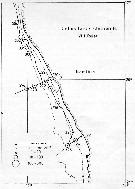 issued from : U. Brenning in Wiss. Z. Wilhelm-Pieck-Univ. Rostock - 31. Jahrgang 1982. Mat.-nat. wiss. Reihe, 6. [p.5, Fig.9]. issued from : U. Brenning in Wiss. Z. Wilhelm-Pieck-Univ. Rostock - 31. Jahrgang 1982. Mat.-nat. wiss. Reihe, 6. [p.5, Fig.9].
Spatial distribution for Calocalanus styliremis from Namibia, expedition VIII (21/9-17/12, 1976) |
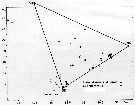 issued from : U. Brenning in Wiss. Z. Wilhelm-Pieck-Univ. Rostock - 31. Jahrgang 1982. Mat.-nat. wiss. Reihe, 6. [p.6, Fig.10]. issued from : U. Brenning in Wiss. Z. Wilhelm-Pieck-Univ. Rostock - 31. Jahrgang 1982. Mat.-nat. wiss. Reihe, 6. [p.6, Fig.10].
T-S diagram for Calocalanus styliremis, and Calocalanus contractus (all copepodid stages) from 8° S - 26° N; 16°- 20° W, and Namibia.
SO: Southern Surface Water (S °/oo: 34,50; T°C: 29,0); ND: Northern Water of the Surface Layer (S °/oo: 37,5; T°C: 21,0); SD: Southern Deep Water of the surface layer (S °/oo: 35,33; T°C: 13,4). See commentary in Temora stylifera and Brenning (1985 a, p.6).
Nota: This species is euryecological form. |
| | | | Loc: | | | Cosmopolite (tropical and temperate, World-wide), South Africa (E & W), also: sub-Antarct. (SW Atlant., N South Georgia, Indian), Bering Sea, Straits of Malacca, Malaysia (Sarawak: Bintulu coast), G. of Thailand, China Seas (East China Sea, South China Sea), Kuchinoerabu Is., Tokyo Bay, British Columbia, Oregon (off Newport), W Baja California, La Paz, Galapagos-Ecuador, Chile (S, off Santiago), Caribbean Colombia, Sargasso Sea, Station "S" (32°10'N, 64°30'W).
Data from Cornils & Blanco-Bercial (2013): 01°00'S; 09°00'W (W Guinea Basin). | | | | N: | 180 | | | | Lg.: | | | (14) F: 0,748-0,66; (34) F: 0,68-0,62; (35) F: 0,74-0,65; (38) F: 0,85-0,8; (47) F: 0,72-0,6; M: 0,55; (55) F: 0,69-0,6; 0,84-0,75; (66) F: 0,64; (114) F: 0,76; (116) F: 0,75; (199) F: 0,68-0,61; (237) F: 0,6-0,7; M: 0,65; (290) F: 0,8-0,6; (338) M: 0,55-0,45; (786) F: 0,68; (866) F: 0,5-0,9; M: 0,5-0,6; (991) F: 0,59-0,95; M: 0,48-0,55; (1023) F: 0,60-0,69; 0,75-0,84; (1112) F: 0,567-0,912 [NW Africa]; 0,72-0,816 [Namibia]; (1132) F: 0,62-0,72; M: 0,55; {F: 0,50-0,95; M: 0,45-0,65} | | | | Rem.: | épipélagique- mesopélagique.
Sampling depth (sub-Antarct.) : 0-50 m.
Voir aussi les remarques en anglais | | | Dernière mise à jour : 25/10/2022 | |
|
|
 Toute utilisation de ce site pour une publication sera mentionnée avec la référence suivante : Toute utilisation de ce site pour une publication sera mentionnée avec la référence suivante :
Razouls C., Desreumaux N., Kouwenberg J. et de Bovée F., 2005-2025. - Biodiversité des Copépodes planctoniques marins (morphologie, répartition géographique et données biologiques). Sorbonne Université, CNRS. Disponible sur http://copepodes.obs-banyuls.fr [Accédé le 27 décembre 2025] © copyright 2005-2025 Sorbonne Université, CNRS
|
|
 |
 |






















